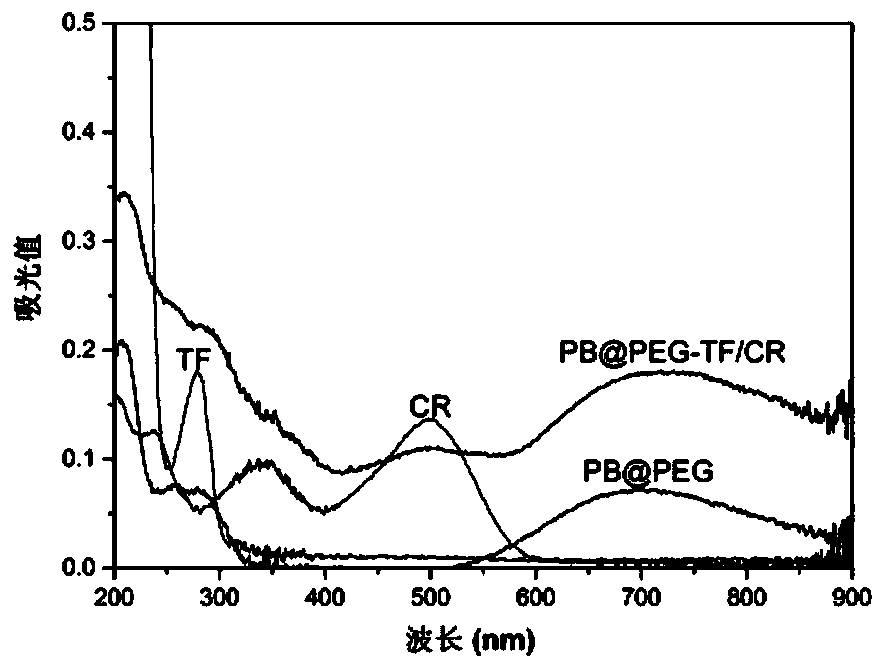Prussian blue nanometer particles for targeting beta age spots and preparation method of prussian blue nanometer particles
A Prussian blue and nanoparticle technology, applied in the field of biomedicine, can solve the problem that Prussian blue nanoparticles are difficult to be modified in a targeted manner, and achieve good biocompatibility and biosafety, simple operation and good stability.
- Summary
- Abstract
- Description
- Claims
- Application Information
AI Technical Summary
Problems solved by technology
Method used
Image
Examples
Embodiment 1
[0030] 1) Dissolve 0.01 mmol of potassium ferrocyanide and 0.001 mmol of mPEG-COOH in 5 ml of deionized water, and mix thoroughly to obtain a clear solution A; dissolve 0.01 mmol of ferric chloride in 5 ml of deionized water, Fully dissolve to obtain a clear solution B; add solution B dropwise to solution A, and react at 60°C for 0.5h;
[0031] 2) Wait until the reaction system is lowered to room temperature, react for 0.5 h, and centrifuge to wash to obtain a precipitate C of Prussian blue nanoparticles modified with polyethylene glycol containing carboxyl groups;
[0032] 3) Precipitate C, 0.1 mmol of 1-(3-dimethylaminopropyl)-3-ethylcarbodiimide hydrochloride were dissolved in 10 ml of carboxyl-containing polyethylene glycol-modified Prussian blue nanoparticles In deionized water, react at room temperature for 15 minutes to obtain solution D;
[0033] 4) Add 0.1 mmol N-hydroxysuccinimide, 0.01 mg transferrin, and 0.4 micromol Congo red to solution D, react at room temperat...
Embodiment 2
[0036] 1) Dissolve 0.005 mmol of potassium ferrocyanide and 0.005 mmol of mPEG-COOH in 5 ml of deionized water respectively, and mix well to obtain a clear solution A; dissolve 0.005 mmol of ferric chloride in 5 ml of deionized water, Fully dissolve to obtain a clear solution B; add solution B dropwise to solution A, and react at 55°C for 0.5h;
[0037] 2) After the reaction system is lowered to room temperature, react for 1 hour, and centrifuge to wash to obtain a precipitate C of Prussian blue nanoparticles modified with polyethylene glycol containing carboxyl groups;
[0038] 3) Precipitate C, 0.05 mmol of 1-(3-dimethylaminopropyl)-3-ethylcarbodiimide hydrochloride were dissolved in 10 ml of carboxyl-containing polyethylene glycol-modified Prussian blue nanoparticles In deionized water, react at room temperature for 10 minutes to obtain solution D;
[0039] 4) Add 0.04 mmol N-hydroxysuccinimide, 0.005 mg transferrin, and 0.48 micromol Congo red to solution D, react at room...
Embodiment 3
[0042] 1) Dissolve 0.0195 mmol of potassium ferrocyanide and 0.003 mmol of COOH-PEG-COOH in 5 ml of deionized water, and mix well to obtain clear solution A; dissolve 0.0195 mmol of ferric chloride in 5 ml of deionized water Fully dissolve in water to obtain a clear solution B; add solution B dropwise to solution A, and react at 60°C for 1 hour;
[0043] 2) Wait until the reaction system is lowered to room temperature, react for 0.5 h, and centrifuge to wash to obtain a precipitate C of Prussian blue nanoparticles modified with polyethylene glycol containing carboxyl groups;
[0044] 3) Precipitation C and 0.12 mmol of 1-(3-dimethylaminopropyl)-3-ethylcarbodiimide hydrochloride were dissolved in 10 ml of carboxyl-containing polyethylene glycol-modified Prussian blue nanoparticles In deionized water, react at room temperature for 25 minutes to obtain solution D;
[0045] 4) Add 0.02 mmol of N-hydroxysuccinimide, 0.02 mg of transferrin, and 0.6 micromol of Congo red to solution...
PUM
| Property | Measurement | Unit |
|---|---|---|
| particle diameter | aaaaa | aaaaa |
| particle diameter | aaaaa | aaaaa |
| particle diameter | aaaaa | aaaaa |
Abstract
Description
Claims
Application Information
 Login to View More
Login to View More - R&D
- Intellectual Property
- Life Sciences
- Materials
- Tech Scout
- Unparalleled Data Quality
- Higher Quality Content
- 60% Fewer Hallucinations
Browse by: Latest US Patents, China's latest patents, Technical Efficacy Thesaurus, Application Domain, Technology Topic, Popular Technical Reports.
© 2025 PatSnap. All rights reserved.Legal|Privacy policy|Modern Slavery Act Transparency Statement|Sitemap|About US| Contact US: help@patsnap.com



